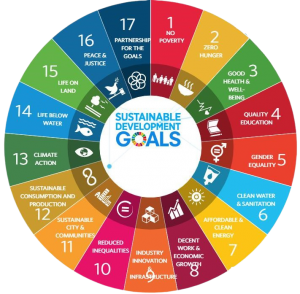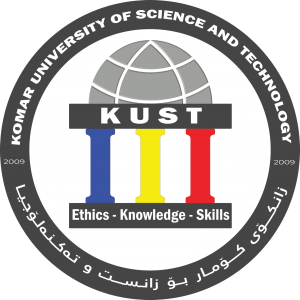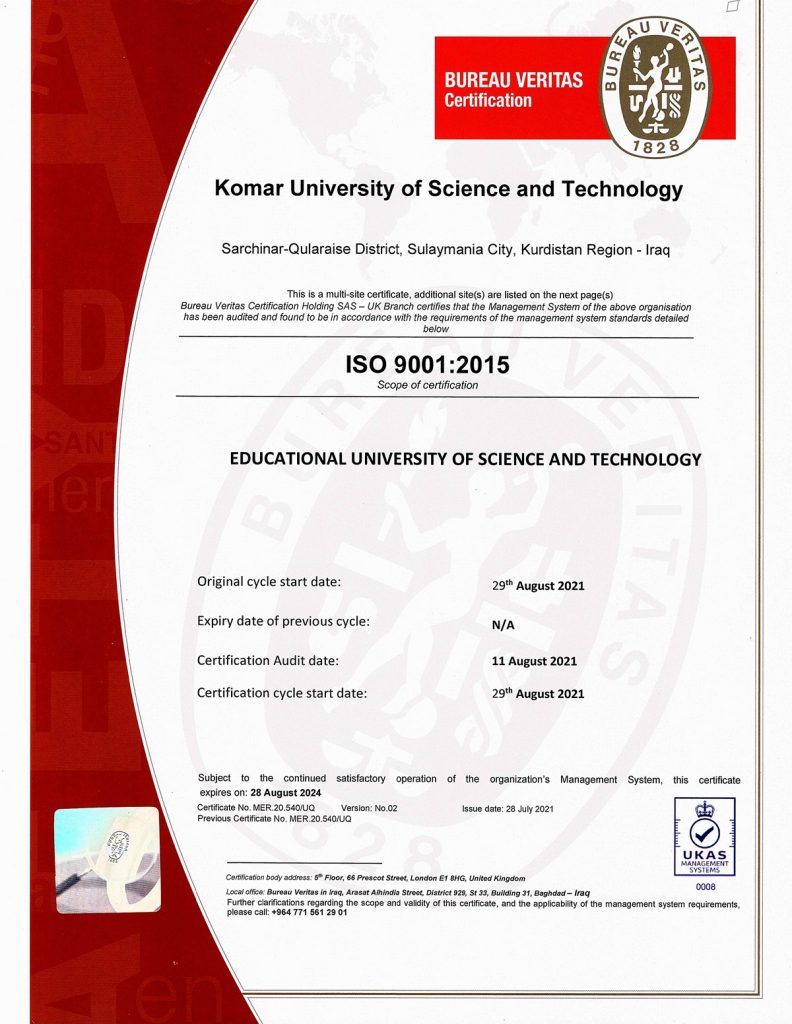President's message on Sustainable Development at KUST
Komar University, since its inception, has been steadfastly dedicated to advancing sustainable development objectives, particularly focusing on specific goals implemented within its operations. Embracing sustainable practices within the institution comes with notable costs, particularly within the context of the Kurdistan Region of Iraq (KRI). However, driven by a firm commitment to enriching the quality of education and assuming a significant societal role, KUST has embarked on courageous initiatives aimed at fulfilling its obligations toward fostering a better future for its graduates and the wider community.
Renowned for its commitment to educational excellence, KUST devises robust annual plans aimed at imbuing the learning process with greater significance for students. Central to its educational approach is the integration of experiential learning methodologies, such as learning by doing, and the adoption of student-centered approaches. Additionally, the university distinguishes itself by providing a premier learning environment in the region, bolstered by state-of-the-art laboratories, virtual learning platforms, blended learning methodologies, and a cadre of esteemed international and local professionals across various disciplines. This dedication has firmly established KUST as a premier educational institution within Iraq and the Kurdistan Region.
 Moreover, KUST actively engages with diverse communities, offering various forms of support, including financial aid for those in need, conducting fundraising campaigns, and organizing awareness initiatives addressing pertinent issues spanning health, environmental conservation, and the application of innovative technologies.
Moreover, KUST actively engages with diverse communities, offering various forms of support, including financial aid for those in need, conducting fundraising campaigns, and organizing awareness initiatives addressing pertinent issues spanning health, environmental conservation, and the application of innovative technologies.
Furthermore, the university has significantly contributed to scientific research endeavors aligned with sustainable development goals. Its scholarly output, spanning areas such as water and solid waste management, as well as renewable energy applications, has garnered recognition in internationally esteemed journals. As such, KUST remains resolutely committed to its vision and mission, steadfastly working towards realizing all facets of sustainable development by the target year of 2030.
GOAL 4
Ensure inclusive and equitable quality education and promote lifelong learning opportunities for all
GOAL 10
Reduce inequality within and among countries
GOAL 13
Take urgent action to combat climate change and its impacts
GOAL 16
Promote peaceful and inclusive societies for sustainable development, provide access to justice for all and build effective, accountable and inclusive institutions at all levels
Goal 2
End hunger, achieve food security and improved nutrition and promote sustainable agriculture.
Goal 8
Promote sustained, inclusive and sustainable economic growth, full and productive employment and decent work for all
Goal 14
Conserve and sustainably use the oceans, seas and marine resources for sustainable development
Goal 17
Strengthen the means of implementation and revitalize the Global Partnership for Sustainable Development
GOAL 9
Build resilient infrastructure, promote inclusive and sustainable industrialization and foster innovation
GOAL 15
Protect, restore and promote sustainable use of terrestrial ecosystems, sustainably manage forests, combat desertification, and halt and reverse land degradation and halt biodiversity loss

KUST Sustainability Policy
Spring 2024

KUST is committed to promoting responsible management, environmental friendly practice, and sustainability within our campus community. Recognizing the importance of conserving resources, reducing waste, and fostering a culture of sustainability, this policy outlines our commitment to sustainable practices in all aspects of university operations.
1. KUST’s Sustainable Resource Management
Sustainable resource management at universities involves employing resources wisely and effectively in order to cut expenses, limit negative effects on the environment, and advance sustainability over a long-term basis.
1.1 Targeted group: All the KUST’s units are involved in.
1.2 Type of the Projects:
1.2.1 Energy Management: Use methods to conserve energy, including installing renewable energy sources like solar (Photovoltaic and Panel) and wind turbines, updating to energy-efficient lighting, and improving HVAC (heating, ventilation, and air conditioning) systems. Conduct energy audits to identify opportunities for improvement and track energy usage every month.
1.2.2 Water Conservation: Take steps to cut down on water usage by installing low-flow fixtures, putting in place irrigation-light landscaping techniques, and quickly fixing leaks. When it’s possible, put greywater reuse and rainfall collection systems into action. Directing the maintenance team to use an eco-friendly and water efficient alternative for any future repair, replacement, or new constructions.
1.2.3 Waste Reduction and Recycling: The objective is to create all-encompassing waste reduction initiatives and promote material recycling, reuse, and source reduction. Make recycling bins widely accessible and teach the campus community effective waste sorting techniques. Examine your choices for composting the organic waste produced on campus. Monitor the monthly and yearly consumption and recycling outcomes
- Digital Documentation: Whenever possible, choose digital documents over printed ones. E-signatures, PDFs, and digital record-keeping not only save paper but also streamline processes.
- Think Before You Print: Before hitting that print button, consider whether a document truly needs to be printed. Often, digital versions suffice for most purposes, reducing unnecessary paper usage.
- Double-sided Printing: When printing is necessary, utilize the double-sided printing feature to maximize paper efficiency and minimize waste.
- Paperless Meetings: Embrace digital tools for presentations, note-taking, and sharing information during meetings to eliminate the need for printed materials.
- Recycle Responsibly: Properly recycle any paper materials that are no longer needed to ensure they are repurposed efficiently.
1.2.4 Transportation Management: Encourage sustainable forms of transportation for staff, faculty members, and students, such as public transportation, walking, cycling, and carpooling. Provide incentives to use carpooling spots, bicycle racks, and parking spaces for alternate modes of transportation.
1.2.5 Building Operations and Design: Create new structures in accordance with high-performance sustainability requirements, such as those required to meet LEED (Leadership in Energy and Environmental Design) certification. To maximize energy consumption and interior environmental quality, upgrade existing buildings with energy-efficient modifications, better insulation, and smart building automation technologies.
1.2.6 Education and Engagement: Use workshops, outreach initiatives, educational indications, and campus gatherings to inform the university community about sustainable resource management techniques. Encourage a culture of environmental stewardship by including administrators, Faculty members,, staff, and students in sustainability programs and decision-making procedures.
1.3 KUST Target: Applying sustainable resource management plan by 30% by 2030 especially minimizing fuel consumption by 10% by 2030 and applying renewable energy by 10% by 2030.
2. Waste Management and Recycling at KUST
On the KUST campus, waste management is a vital component of environmental responsibility and sustainability. Therefore, KUST is planning to set a target towards minimizing and managing different types of waste at the university level.
2.1 Targeted group: All the units at KUST are involved in this project.
2.2 Type of the projects: There are some steps to be done within the coming years as follows:
2.2.1. Waste Minimization Plan: This must start with all the units via practicing the minimization of waste in daily activities and a yearly plan must be activated by each unit to have a target within a year. Departments For instance: the plan is to use paper only once needed rather than wasting a lot of paper. Each unit will have to compete on minimizing waste at his/her unit with other units at KUST.
2.2.2. Waste Segregation process in all the KUST buildings: By implementing a comprehensive waste segregation system by providing separate-colored bins for recyclables (paper, plastics, metals), organic waste, and non-recyclable waste. This has to cover all the buildings and Laboratories.
2.2.3. Clinical and Hazardous Waste Management: This type of waste needs a well-planned management system throughout all the Labs and clinics at KUST. Training of the staff who will have daily exposure to this waste is required.
2.2.4. Recycling and Reuse plan: This will establish the culture of recycling and reusing different materials at KUST. Every unit must have a yearly plan to list the materials that can be recycled/reused within his/her unit.
2.2.5. Monitoring and Evaluation: This step is yearly needed to keep checks on the advancement of waste reduction objectives, and periodically assess the rates of waste generation and diversion at KUST. Identify areas for improvement using this data.
2.3 KUST Target: KUST has a yearly target by minimizing its waste by 10-15% by 2030.
3. KUST Sustainable Learning Environment
KUST must use a variety of strategies and factors to create a sustainable learning environment that supports economic, social, and ecological sustainability while promoting the achievement and well-being of their students.
3.1 Targeted group: All the faculty members and students are involved.
3.2 Type of the projects:
3.2.1 Curriculum Integration: Integrate sustainability concepts into various fields by adding sustainability-related content to already-existing courses or creating new courses that are specifically focused on sustainability.
3.2.2 Interdisciplinary Approach: To solve complex sustainability concerns from different viewpoints, encourage interdisciplinary collaboration among departments and faculties.
3.2.3 Practical Learning: Give students the chance to participate in practical, real-world sustainability projects through internships, research projects, and community collaborations.
3.2.4 Campus Operations: Incorporate sustainable practices into campus operations, such as reducing waste and recycling, using less energy and water, designing green buildings, buying eco-friendly products, and using sustainable transportation alternatives.
3.2.5 Green places: Establish and preserve green places for relaxation, entertainment, and teaching about the environment on campus. Include natural plants, eco-friendly gardening techniques, and outdoor learning spaces.
3.2.6 Student-Centered Approaches: Through students-run clubs, organizations, and sustainability committees, encourage students to actively participate in sustainability activities. Give students the chance to take the lead and make decisions on sustainability initiatives.
3.2.7 Faculty Development: Provide chances for faculty members to grow professionally so they may become more knowledgeable and proficient in teaching sustainability, including sustainability into plans for research, and applying sustainability concepts to their scholarly work.
3.2.8 Communication and Awareness: Use outreach programs, workshops, seminars, and educational campaigns to educate students, teachers, staff, and the general public about sustainability concerns and efforts.
3.2.9 Graduation projects: a minimum of 25% of the proposed graduation projects in each department should target addressing sustainability related issues.
3.3 KUST Target: KUST should apply 50% of this policy by the end of 2030.
4. KUST Sustainable Research and Innovations
KUST should undertake research and create answers for critical environmental, social, and economic issues while advancing long-term sustainability. This is known as sustainable research and innovation.
4.1 Targeted group: All the faculty members and research-fellows at KUST are involved in.
4.2 Type of the projects:
4.2.1 Interdisciplinary Collaboration: To address difficult sustainability challenges from different viewpoints, encourage academics and students from varied academic fields to work in interdisciplinary research teams. Holistic solutions can result from collaboration amongst disciplines including environmental science, engineering, social sciences, economics, and humanities.
4.2.2 Research Funding: Distribute funds and resources through business partnerships, charitable organizations, government agencies, and internal grants to support research initiatives with a sustainability focus. Funding for research with the potential to have practical applications and that is in line with sustainability goals should be given priority.
4.2.3 Sustainability Research Centers and institutions: To promote cooperation, provide resources, and oversee multidisciplinary projects, establish centers or institutions specifically devoted to sustainability research and innovation. These facilities can act as focal points for networking, information sharing, and collaborations with other parties.
4.2.4 Technology Development: Encourage the creation of cutting-edge engineering solutions and technologies that advance sustainability goals. Examples include clean transportation options, waste reduction and recycling procedures, energy-efficient technologies, renewable energy systems, and sustainable agricultural practices.
4.2.5 Education and Outreach: To increase awareness, develop capacity, and inspire people and communities to take action, incorporate the results of sustainability research into educational initiatives and outreach campaigns. Share study results in easily understood forms, and work with stakeholders to jointly develop solutions that are appropriate for various social and cultural contexts.
4.2.6 Education and Outreach: 15% extra will be added to the research publication awards per the university policy if the research is linked to the UNSDGs.
4.3 KUST Target: KUST should focus more on the research related to Sustainable Development goals. KUST must reach up to 25% of its research products on SDGs by 2030.
The Cycle of the Follow-up Process
A. Assessment and Analysis: Conduct a comprehensive assessment of current resource use, practices, and infrastructure to identify areas for improvement and opportunities for sustainability integration. Analyze the environmental impact of existing processes and practices to prioritize areas for transition to sustainable alternatives.
B. Pilot Programs and Demonstrations: Launch pilot programs to test and evaluate the effectiveness of sustainable solutions in real-world settings. Showcase successful demonstrations and case studies to inspire and motivate broader adoption of sustainable practices.
C. Monitoring and Evaluation: Establish monitoring and evaluation mechanisms to track progress towards sustainability goals and targets. Regularly assess the performance of sustainability initiatives and adjust strategies as needed to ensure continuous improvement.
D. Continuous Improvement: We are committed to regular review and evaluation of our sustainability performance to identify areas for improvement and set targets for progress. Solicit feedback from the university community and stakeholders to inform ongoing sustainability
E. Initiatives and decision-making processes: Periodically update and revise this policy to reflect evolving best practices and emerging sustainability priorities.
Vision
The Sustainable Development Committee at KUST may greatly strengthen the University’s social and environmental responsibility dedication. In addition to achieving the Sustainable Development Goals that the UN has addressed, this committee aims to promote a culture of sustainable development at all levels.
Mission
The committee is dedicated to fostering a greener KUST campus by 2030 through the promotion of environmentally sustainable practices and the maximization of renewable energy utilization. We aim to establish diverse clubs and research groups focusing on sustainable development projects, engaging students in initiatives that directly contribute to the realization of sustainable development goals.










